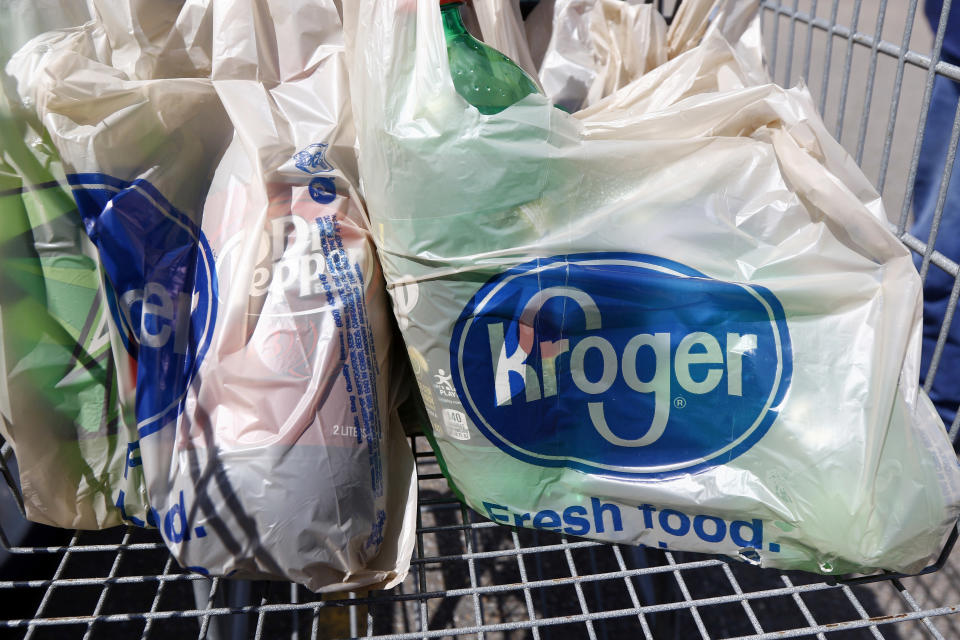Inflation, Kroger earnings — What you need to know in markets on Thursday
New iPhones are here.
On Wednesday, Apple (AAPL) announced three new iPhones and a new Apple Watch at its latest event at the company’s headquarters in California. the most expensive iPhone, the iPhone Xs Max, will cost $1,099.
The new phones feature faster FaceID, better speakers, and an improved display. The iPhone Xs-series camera has an improved camera with a new, larger sensor and bigger pixels with a faster processor to enable users to change the depth-of-field of a photo after you take it.

Yahoo Finance columnist David Pogue, however, captured the overwhelming vibe of the event, saying Wednesday that, “Apple execs onstage are talking about the new iPhone Xs models—and glowingly describing OLD features.”
“In other words, there appears to be not a single new feature!”
Apple shares finished the day down 1.2%.
Elsewhere in the way of market-moving news on Wednesday, The Wall Street Journal reported that Treasury Secretary Steven Mnuchin this week sent an invitation to his Chinese counterparts for another meeting to discuss the U.S.-China trade agreement. This news sent markets higher though these gains were eventually faded as each of the major indexes closed little-changed on Wednesday.
On Thursday, investors will get key inflation data in the morning with the August report on consumer prices set for release at 8:30 a.m. ET. Expectations are for “core” CPI — which strips out the more volatile costs of food and gas — to show an increase of 2.4% over the prior year. This would be in-line with the increase seen in June.
Investors will also get the weekly report on initial jobless claims.
The earnings calendar on Thursday will also bring investors the only two S&P 500 members reporting results this week, with Kroger (KR) and Adobe (ADBE) releasing quarterly updates.
Kroger’s results, due out before the market open, will be of interest to investors as Amazon (AMZN), Walmart (WMT), Target (TGT) and others try to make inroads into grocery delivery. Kroger earlier this year introduced online delivery in some markets.
Expectations are for the country’s largest grocer to report earnings per share of $0.38 on revenue of $28.1 billion with same-store sales set to rise 2.2%.

The Beige Book take on the labor market
The U.S. labor market right now is tight.
The number of workers quitting is surging.
The number of jobs open is at a record high.
And the amount of money workers are making is on the rise.
This dynamic has lead to many complaints from would-be employers about how they can’t find the right workers for various jobs, and the Federal Reserve’s Beige Book has in recent months been instructive in outlining the ways employers are trying to work around just giving prospective workers raises.
On Wednesday, the latest edition of this Fed report — a collection of economic anecdotes from each of the central bank’s 12 districts — outlined the non-wage incentives that companies are trying to use to lure prospective employees.
Commentary from the New York Fed said, “A major New York State employer noted success in using non-wage benefits (e.g., vacation, flexible hours) to attract younger workers.”
In the Cleveland Fed’s district, business contacts said, “A number of firms are boosting training efforts and considering alternatives to alleviate the shortage… A few transportation and manufacturing contacts reported that they were having to give off-cycle wage increases to retain workers. One auto dealer increased incentives and starting pay for midlevel technicians, while a retailer noted the contact’s firm’s new bonus program had helped keep turnover in check.”
The Atlanta Fed’s district showed the creativity that employers are showing in finding ways not to raise wages, with contacts in that region indicating, “wage pressure was growing; however, increases greater than 2 to 3 percent remained targeted, rather than broad-based.”
The report added that, “In response, firms continued to approach compensation creatively (e.g., offer enhanced flexibility, use bonuses and other incentive pay, and offer profit sharing or other forms of temporary compensation that can be discontinued if necessary). Reports from some firms indicated that they were unable to pay the higher wages demanded by experienced job seekers. Instead, they shifted their focus on higher margin business lines or planned to ‘wait it out’ and not to fill the positions.”
For employers, then, it seems that wage increases and the competition for labor that has become a feature of the economy in recent years is seen as something like a phase. If businesses believe they can “wait out” the need to hire workers and hope the business cycle slows or the labor market deteriorates to the point where they retain leverage, it seems we’re being set up for a future economic moment when wages and growth unexpectedly accelerate.
—
Myles Udland is a writer at Yahoo Finance. Follow him on Twitter @MylesUdland


